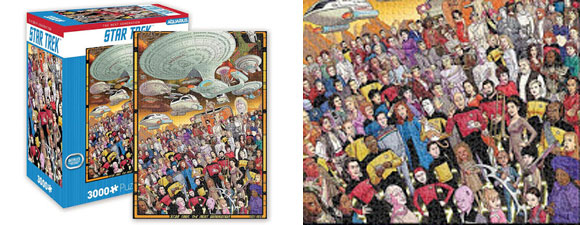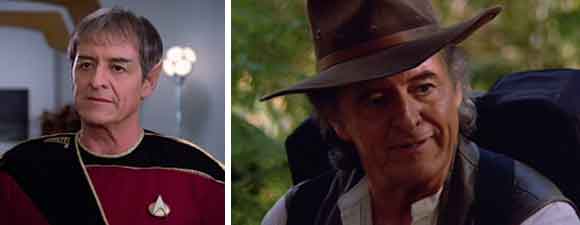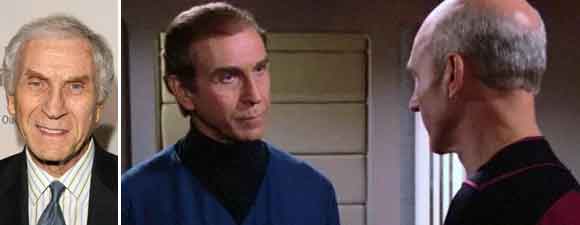Retro Review: All Good Things…
10 min readPicard leaps back and forth in time, warned by Q that he must figure out why or bring about humanity’s destruction.
Plot Summary: As Troi and Worf discuss their romantic life, Picard races from a turbolift in his pyjamas and demands to know the date. He tells them that he has been moving back and forth in time, and before he can finish explaining, he finds himself working in his family’s vineyard in France more than two decades in the future. LaForge has come to visit because the engineer – who now has working eyes – learned that Picard has been diagnosed with a degenerative mental condition called Irumodic Syndrome. Picard sees angry people like the ones who were at the mock trial presided over by Q when Picard first took command of the ship. Moments later, Picard finds himself on a shuttlecraft being piloted by Tasha Yar, on the way to see the Enterprise for the first time. When he returns to the present, he goes directly to Sickbay, where Crusher says she can find no evidence that Picard ever left the ship but he has a lot of activity in the part of his brain that forms new memories. Picard asks her to test him for Irumodic Syndrome. He receives a message from Starfleet telling him that four Romulan ships are headed to the Neutral Zone, apparently to a new spatial anomaly in the Devron System; the Enterprise is ordered to follow. Leaping into the future, Picard tells LaForge that he just jumped through time and wants to talk to Data, so the two travel to Cambridge, where Data holds Sir Isaac Newton’s chair at the university. Then Picard jumps to the past, where he sees the people from the trial as he first takes command and puts the crew at battle stations. Starfleet cancels the Enterprise’s mission to Farpoint Station but Picard insists that they must go there anyway, convinced that Q will appear, although in this timeline an anomaly has appeared in the Devron System as well. The future Picard guesses that the anomaly must exist in his time as well and asks for help reaching the Neutral Zone, first from Admiral Riker, who refuses since the Klingons have invaded the Romulan Empire, then from Beverly Crusher, who in the future is Picard’s ex-wife and a captain of a medical transport with clearance to bring emergency supplies to Romulus. The past Picard finally makes contact with Q, who tells Picard that his time travel is indeed related to the spatial anomaly and that humanity is still on trial. Q admits to being responsible for Picard’s time jumps but not for the imminent destruction of humanity, which Q claims will be brought about by Picard himself.
In the present, Picard speculates that perhaps Q is trying to help them by showing Picard the anomaly in the past, when it is much larger, and in the future, when – so far as Beverly Crusher Picard’s crew can tell – it doesn’t yet exist. Picard insists on scanning for it using the inverse tachyon pulse that Data has recommended, though the future Beverly warns him that he may be hallucinating. Picard recommends the tachyon pulse to penetrate the anomaly in each other timeline, which in the present makes LaForge’s eyes regenerate and causes the development of Ogawa’s unborn baby to revert. Data suggests that the anomaly is an eruption of anti-time into their universe, which Crusher says may have grave long-term effects on everyone alive in its vicinity. In the future, Klingons destroy the medical transport moments after Riker arrives on the Enterprise to rescue the crew. Though Riker intends to depart immediately, Q whisks Picard away to ancient Earth, where the anomaly fills much of the quadrant and prevents the earliest form of life on Earth from developing. Guessing that his own actions must have created the anomaly, which grows larger in the past and prevents humanity from evolving, Picard uses a guess from the past Data to have the present Data change scanning methods, revealing that the center of the anomaly reveals three tachyon pulses converging. Since all three Enterprises have used such pulses, the future Picard persuades Riker to return to the Devron System, where the anomaly has just begun to form. The Data in each timeline shuts down the tachyon pulses, but the anomaly cannot be eradicated without the use of a static warp shell to isolate the anti-time eruption. All three Enterprises enter the anomaly to create the warp shell and are destroyed one by one as the anomaly begins to collapse. Picard finds himself back in Q’s courtroom, where he is told that he has succeeded in saving humanity by demonstrating the capacity for mental growth. Picard is returned to the moment when he first asked Troi and Worf for the date. Nobody else among the senior crew remembers any of the events, but Picard fills them in, joining their weekly poker game to be certain that they don’t drift apart as they did in the future he saw.
Analysis: “All Good Things…” is considerably more fun than it is to try to summarize, given that it’s easier to distinguish old!man!Picard from early!uniform!Picard visually, and that the presence of different characters in each timeline indicates when we’re not on our familiar Enterprise of the present. It’s a good idea for an episode, though the plot gets more convoluted than necessary and the science is ridiculous. The writers have a lot of loose ends and nostalgia trips they want to work into this final episode of Star Trek: The Next Generation, so I can’t really fault them for that. It’s such a pleasure to see Tasha Yar again, and LaForge happily married to Leah Brahms, and Data living his dream of being an eccentric, emotional professor with lots of cats, and the Riker/Troi/Worf triangle left nicely ambiguous…I always wanted Riker and Troi to end up back together, so it all went as it should have, as far as I’m concerned. I know several people who despise this episode because of the offscreen future Picard/Crusher marriage and divorce, but at least we finally see some resolution there, and it seems realistic to me if not terribly romantic; given a choice between staying home for the rest of her days to nurse an increasingly demented Picard or taking the opportunity to command a medical ship, I can’t blame Crusher for believing not only that she’d be more use out in space, but that a Picard in full possession of his faculties would want that for her and her potential patients – really, I accept that more easily than I accept her taking and keeping his last name after all those years as Beverly Crusher. I’m not sure I like the implication that it’s these friendships and not some deeper connection anchoring Worf to the Federation, that he’d join a militaristic Klingon High Council rather than remain in Starfleet, but everyone else’s future seems pretty solid. It’s hard for me to get too worked up about the crew going their separate ways, particularly seeing how easily they all begin to work together again when the universe is at stake (and, perhaps, knowing that in real life, most of the cast of this series remained good friends).
Though I enjoy Patrick Stewart’s performance very much, I’m a bit sorry that “All Good Things…” is such a Picard-heavy episode because we see so little of the other regulars outside of their routine roles, though I enjoy the interactions with the more nurturing, less engine-obsessed Future LaForge – finally we get to see Geordi’s eyes for an extended time – and the scenes with Yar, who got far too little of substance to do in her brief time aboard, are wonderful. It’s nice to have O’Brien back, too, in his first-season role as a minor techie, since by now he’s the senior engineering officer on Deep Space Nine. The aging makeup is less than ideal, so it’s a bummer that we see Jonathan Frakes primarily in snippets from the first season on a viewscreen and in Grumpy Old Man mode; with Worf, at least, there’s significant interaction in the flashbacks, including a bittersweet moment in which Picard gives him and order and Yar, alarmed, says that she thought she was Chief of Security unless Picard intends to make a change. The older Worf from the future is not a merry man at all, having lost both his seat on the Council and Deanna Troi, but he’s an intriguing character and I wish we had time to find out what happened to Alexander and his Starfleet career and all the rest. Michael Dorn does a really nice job with the subtle similarities and differences in the character in three eras, as does Brent Spiner with Data, though Data’s personality hasn’t changed so much as his propensity to ask annoying questions and miss jokes. Marina Sirtis probably has the most thankless job, since Troi is in full “let’s talk about feelings” mode in the flashbacks and dead in the future – I wish the writers had given her more to do. As for Gates McFadden, she plays Crusher as seeming to have developed a strange and inexplicable accent in the future; sometimes it sounds like she’s mocking Picard, though maybe she just sounds more like him after (presumably) many years of living together.
As for the plot, I suppose one more giant spatial anomaly was an inevitability. I love the epic, dismal scene on primordial Earth, which begins in a classic cheesy Star Trek cave set and moves out to a skyscape dominated by the now-terrifying anomaly. It makes up for the nonsense of the anti-time eruption, LaForge’s eyes healing because they’re reverting, Ogawa losing her fetus because it’s devolved to an embryonic state (a phenomenon that should be killing the rest of the crew much more quickly, or creating a “Counter-Clock Incident” in which we’re subjected to underage officers). There’s also a huge continuity error in terms of the anomaly’s growth – Riker should not be able to take the Enterprise back to the Devron System (and forward in time) to find an anomaly that ages backwards. It’s certainly not the Trek science writers’ finest moment, though except for a few overlong sequences of technobabble with Picard jumping from era to era giving orders involving tachyon pulses and static warp bubbles, it serves its purpose of creating a reason to show the crew in multiple eras. (And gives the writers an excuse to dump the idiotic limitation on warp speed!) Though many original series Trekkers weren’t big fans of “Encounter at Farpoint” when it aired, and it took several seasons for Q to grow on us, I think it was smart to bring him back, to tie the series back into big themes it has touched upon without hitting us over the head with them – too much spirituality on a sci-fi series can be extremely irritating, though I think we’ve established with Q that he’s not remotely godlike. The structure lets the writers tie a neat ribbon around the series as if all the missteps were planned in advance – as Q says, the trial never ends – and also allows for a direct comparison of how much the characters and their relationships have grown.
I know many people who cried after this episode, knowing that it would be the last. I wasn’t one of those when it originally aired – I was too deeply in love with Deep Space Nine, which was finishing up what I still believe is the best single season ever of a major science fiction show, and was hoping that the writing staff would be turning its full attention to that series, not yet understanding the ramifications of UPN’s launch and the need to make Voyager the more recognizable show. I fell in love with Voyager even more quickly, so all through this rewatch of Next Gen, I keep asking myself why it took me so long truly to appreciate what many fans believe is the best of the series overall. It didn’t help that the first season was weak and the final one uneven, so I never built up that compulsive fannish “must-see” compulsion that I had with the other shows in the franchise and when I thought back on the end there were a lot of episodes that didn’t leave a strong impression. I was irritated at the time that neither of the series-long romances ended well – when you drop hints in the first two episodes that there are two couples with long-simmering romantic passion, don’t you owe it to the fans to bring one of them at least to a satisfactory conclusion? That happened later, of course, but when Next Gen departed the airwaves with a film already in progress, we couldn’t have known that there would be three additional movies to follow. And a movie is something very different from a weekly TV series, where for half a year the characters appear in our living rooms while we go about various other aspects of our lives.
“All Good Things…” is one of the series’ most acclaimed episodes, having won a Hugo Award and several Emmy nominations. Many of my personal favorite Next Gen memories don’t have much to do with the show at all. They include going to see several cast members on stage in Every Good Boy Deserves Favour, meeting Jonathan Frakes by chance in a hotel lobby with my parents (I’ve heard fans complain about him because he doesn’t always sign autographs, so I just want to say that he was utterly charming – he posed for a picture with my mom and me), seeing Patrick Stewart in a number of Shakespeare plays. Much later, when my job intersected with my love of Star Trek, I got lucky enough to interview several of the cast members, every one of whom lived up to anything I could have wished. In some ways, I’m sadder to have finished it this time around than I was when it actually went off the air. On the other hand, now I get to review the animated series, which I’ve actually never watched all the way through…and after that, it’s time for a full DS9 rewatch, which I can’t wait to do.






